Big Ideas Math Algebra 1 Student Journal 1st Edition Chapter 4 Writing Linear Functions
Page 121 Essential Question Answer
Given: Patten is an arithmetic sequence
To find a Method to describe the pattern using an arithmetic sequence.
An arithmetic sequence is an ordered list of numbers in which the difference between each pair of consecutive terms, or numbers in the list, is the same.
To describe the pattern using an arithmetic sequence, take the difference of their consecutive term and you get these all differences are same.
Page 122 Exercise 2 Answer
Given: Pattern is an arithmetic sequence.
To find An example from real life to describe an arithmetic sequence.
Real-life example: In a passenger train, there are 125 passengers in the first carriage, 150 passengers in the second carriage and 175 passengers in the third carriage. If the total carriage in a train is 8, then find the number of passengers in 6th
carriage.
So, in this real-life problem, the number of passengers in the carriage is in arithmetic sequence because there is a common difference(d) between The number of passengers i.e.d=150−125
d=25 and first term(a) is 125.
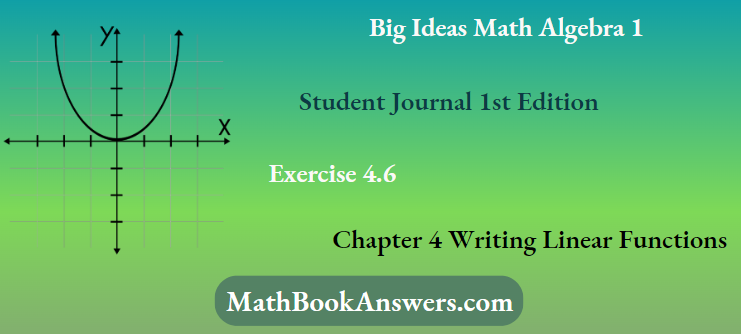
Real-life example: In a passenger train, there are 125 passengers in the first carriage, 150 passengers in the second carriage, and 175 passengers in the third carriage. If total carriage in a train is 8, then find the number of passengers in 6thcarriage.
Big Ideas Math Algebra 1 Chapter 4 Exercise 4.6 Solutions
Page 122 Exercise 3 Answer
Given :

To find the Number of atoms in 23 molecules.
In order to find the solution, count the number of atoms till n=5
and make a sequence then find a23.
Count the number of atoms in their respective number of molecules.
So, the sequence will be, 3,6,9,12,15,…….
Here, a1=3
d=6−3
=3
For a23, put n=23 in an=a1+(n−1)d
a23=a1+(23−1)d
a23=3+22×3
a23=69
There are 69 number of atoms in 23 molecules.
Page 124 Exercise 1 Answer
Given sequence: 1,8,15,22,…
To find the next three terms of the arithmetic sequence.
In order to find the solution, get the value of first term a1 and common difference d then use the formula
an=a1+(n−1)d
As the given sequence is 1,8,15,22,…
And a1=1
d=8−1
=7
For the next three terms, calculate a5,a6, and a7.
For a5, put n=5 in above formula
an=a1+(5−1)d
a5=(1)+(4)⋅(7)
=1+28
=29
For a6, put n=6
an=a1+(6−1)d
a6=(1)+(5).(7)
=1+35
=36
For a7,put n=7
an=a1+(7−1)d
a7=(1)+(6).(7)
=1+42
=43
The next three terms of the arithmetic sequence will be 29,36,43.
Writing Linear Functions Chapter 4 Exercise 4.6 Answers
Page 124 Exercise 2 Answer
Given sequence: 20,14,8,2,…
To find the next three terms of the arithmetic sequence.
In order to find the solution, get the value of the first term a1 and common differences then use the formula
an=a1+(n−1)d
As the given sequence is 20,14,8,2,…
And a1=20
d=14−20
=−6
For the next three terms, calculate a5, a6, and a7.
For a5, put n=5 in above formula
an=a1+(5−1)d
a5=(20)+(4).(−6)
=20−24
=−4
For a6 , put n=6 in above formula
an= a1+(6−1)d
a6= (20)+(5)⋅(−6)
= 20−30
= −10
For a7, put n=7
an= a1+(7−1)d
a7= (20)+(6)⋅(−6)
= 20−36
=−16
So, the next three terms will be−4,−10,−16.
The next three terms of the arithmetic sequence will be −4,−10,−16.
Big Ideas Math Student Journal Exercise 4.6 Explained
Page 124 Exercise 3 Answer
Given sequence: 12,21,30,39,…
To find the next three terms of the arithmetic sequence.
In order to find the solution, get the value of the first term, a1, and common difference,d then use the formula
an= a1+(n−1)d
As the given sequence is 12,21,30,39,…
And a1=12
d=21−12
=9
For the next three terms, calculate a5, a6, and a7
For a5, put n=5 in above formula
an= a1+ (5−1)d
a= (12)+ (4)⋅(9)
= 12 + 36
= 48
For a7, put n=6
an= a1 + (6−1)d
a7= (12) + (5).(9)
= 12 + 45
= 57
For a7, put n=7
an = a1 + (7−1)d
a7 = (12) + (6)⋅(9)
= 12 + 54
= 66
The next three terms of the arithmetic sequence will be 48,57,66.
Page 124 Exercise 4 Answer
Given sequence: 5,12,19,26,…
To find the Next three terms of the arithmetic sequence.
In order to find the solution, get the value of the first term,a1, and common difference,d then use the formula
an=a1+(n−1)d
As the given sequence is 5,12,19,26,…
And a1=5
d=12−5
=7
For the next three terms, calculate a5, a6, and a7
For a5, put n=5 in above formula
an=a1+(5−1)d
a5=(5)+(4).(7)
=5+28
=33
For a6, put n=6 in above formula
an=a1+(6−1)d
a6=(5)+(5)⋅(7)
=5+35
=40
For a7 , put n=7
an=a1+(7−1)d
a7=(5)+(6)⋅(7)
=5+42
=47
So, the next three terms will be 33,40,47.
The next three terms of the arithmetic sequence will be 33,40,47.
Chapter 4 Writing Linear Functions Exercise 4.6 Practice
Page 124 Exercise 5 Answer
Given sequence: 3,7,11,15,…
To find the next three terms of the arithmetic sequence.
In order to find the solution, get the value of the first term, a1, and common difference,d then use the formula
an=a1+(n−1)d
As the given sequence is 3,7,11,15,…
And a1=3
d=7−3
=4
For the next three terms, calculate a5,a6, and a7.
For a5, putn=5 in above formula
an=a1+(5−1)d
a5=(3)+(4).(4)
=3+16
=19
For a6, put n=6
an=a1+(6−1)d
a6=(3)+(5)⋅(4)
=3+20
=23
For a7, put n=7
an=a1+(7−1)d
a7=(3)+(6)⋅(4)
=3+24
=27
So, the next three terms will be 19,23,27.
The next three terms of the arithmetic sequence will be 19,23,27.
Page 124 Exercise 6 Answer
Given sequence: 2,14,26,38,…
To find the next three terms of the arithmetic sequence.
In order to find the solution, get the value of the first term,a1, and common difference,d then use the formula
an=a1+(n−1)d
As the given sequence is2,14,26,38,…
And a1=2
d=14−2
=12
For the next three terms, calculate a5,a6, and a7
For a5, putn=5 in above formula
an=a1+(5−1)d
a5=(2)+(4).(12)
=2+48
=50
For a6, put n=6
an=a1+(6−1)d
a6=(2)+(5)⋅(12)
=2+60
=62
For a7, put n=7
an=a1 +(7−1)d
a7=(2)+(6)⋅(12)
=2+72
=74
So, the next three terms will be 50,62,74.
The next three terms of the arithmetic sequence will be 50,62,74.
Page 124 Exercise 9 Answer
Given sequence is : \(\frac{15}{2}, \frac{13}{2}, \frac{11}{2}, \frac{9}{2}\),……
To find a Graph the given arithmetic sequence.
In order to find the solution, use the order of terms,n in x-axis and the value of terms in y-axis.
To make a graph, plot the points : \(\left(1, \frac{15}{2}\right)_t\left(2, \frac{13}{2}\right)_1\left(3, \frac{11}{2}\right)_{,}\left(4, \frac{9}{2}\right)\).
Here, the order of terms is in the x-axis, and the value of terms in the y-axis.The graph will be
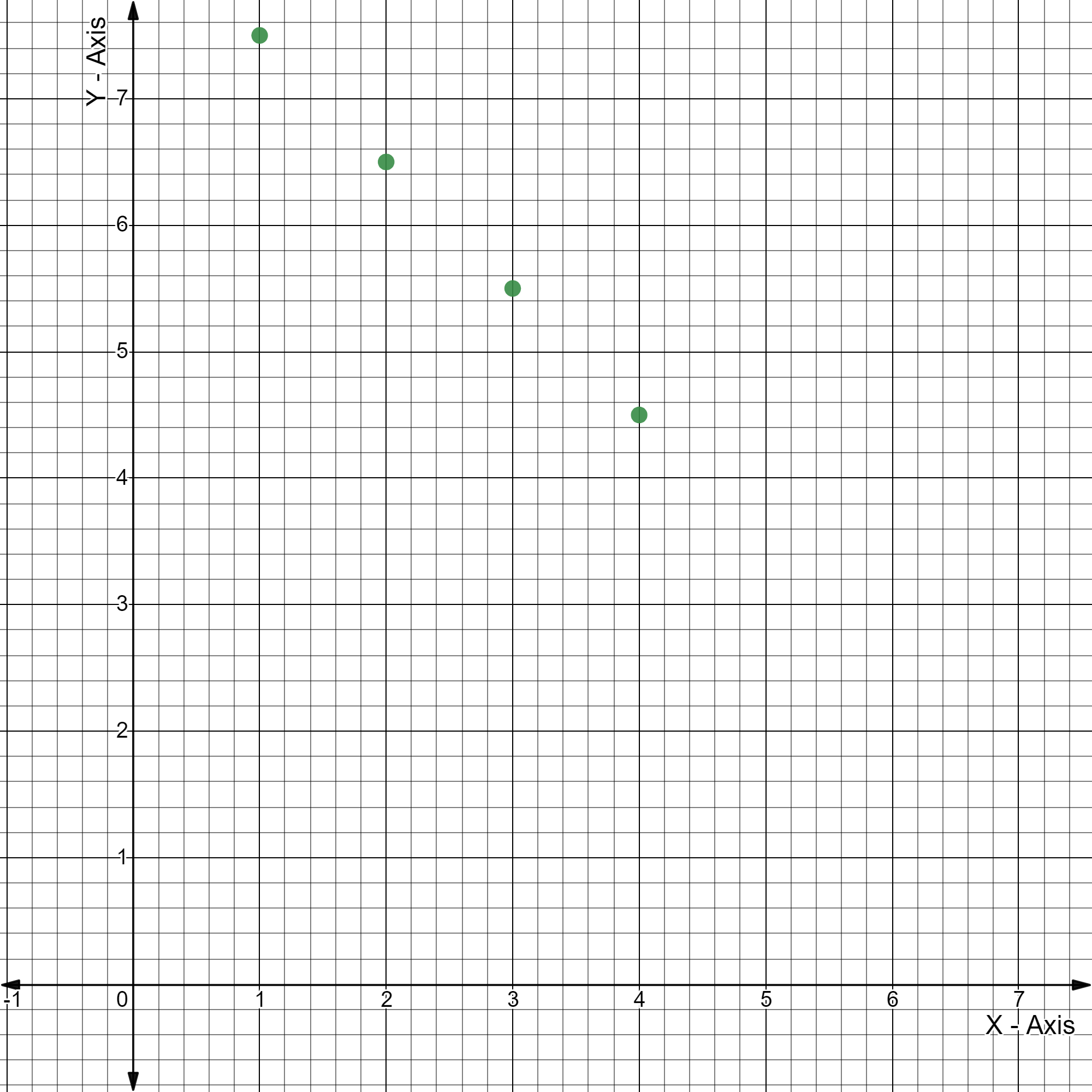
Graph of a given arithmetic sequence
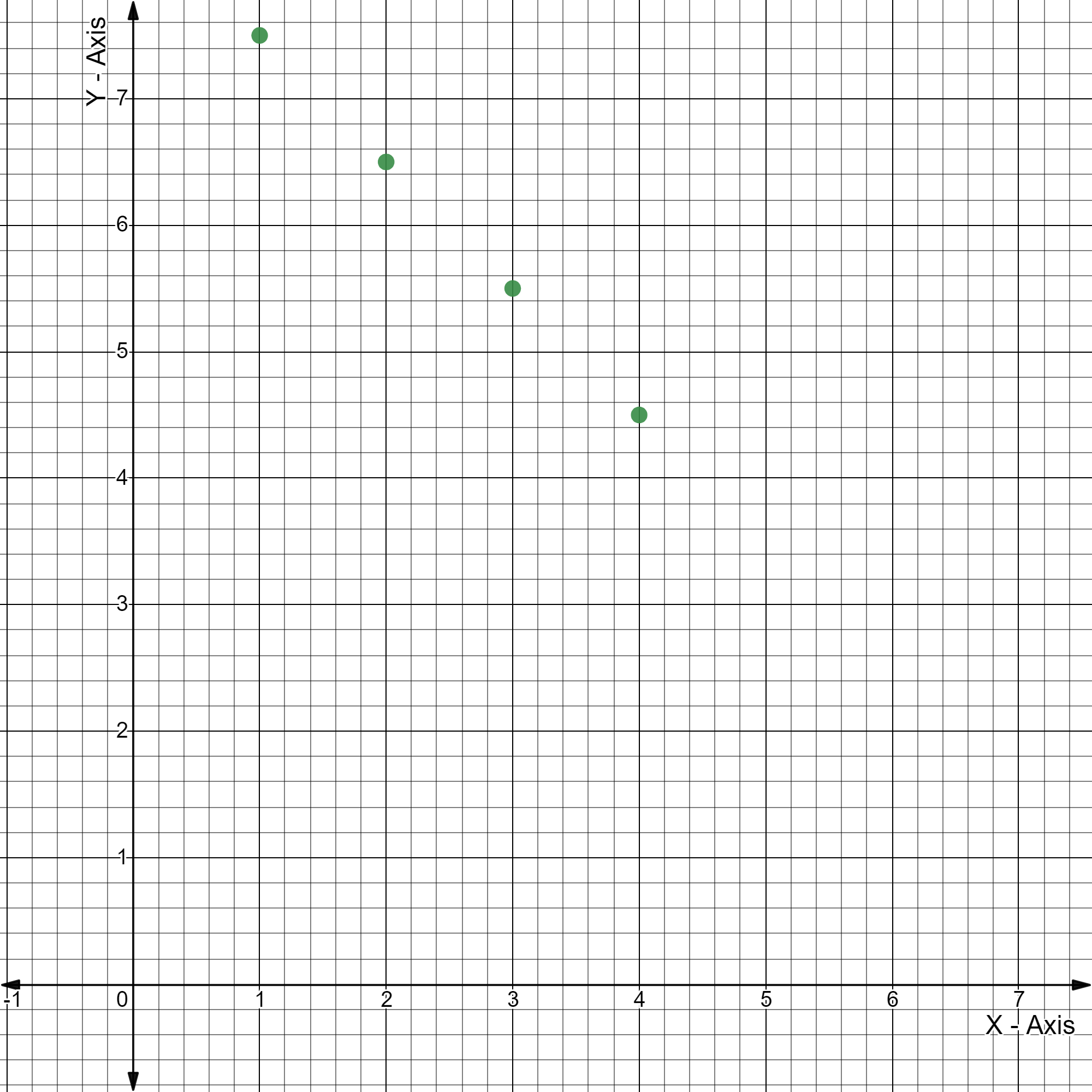
How To Solve Exercise 4.6 Big Ideas Math Chapter 4
Page 124 Exercise 10 Answer
Given sequence is 1,2.5,4,5.5,…
To find a Graph of the given arithmetic sequence.
In order to find the solution, use the order of terms,n in x -axis, and the value of terms in y-axis.
To make a graph, plot the points :(1,1),(2,2.5),(3,4),(4,5.5).
Here, the order of terms is on x-axis, and the value of terms on y-axis.
The graph will be
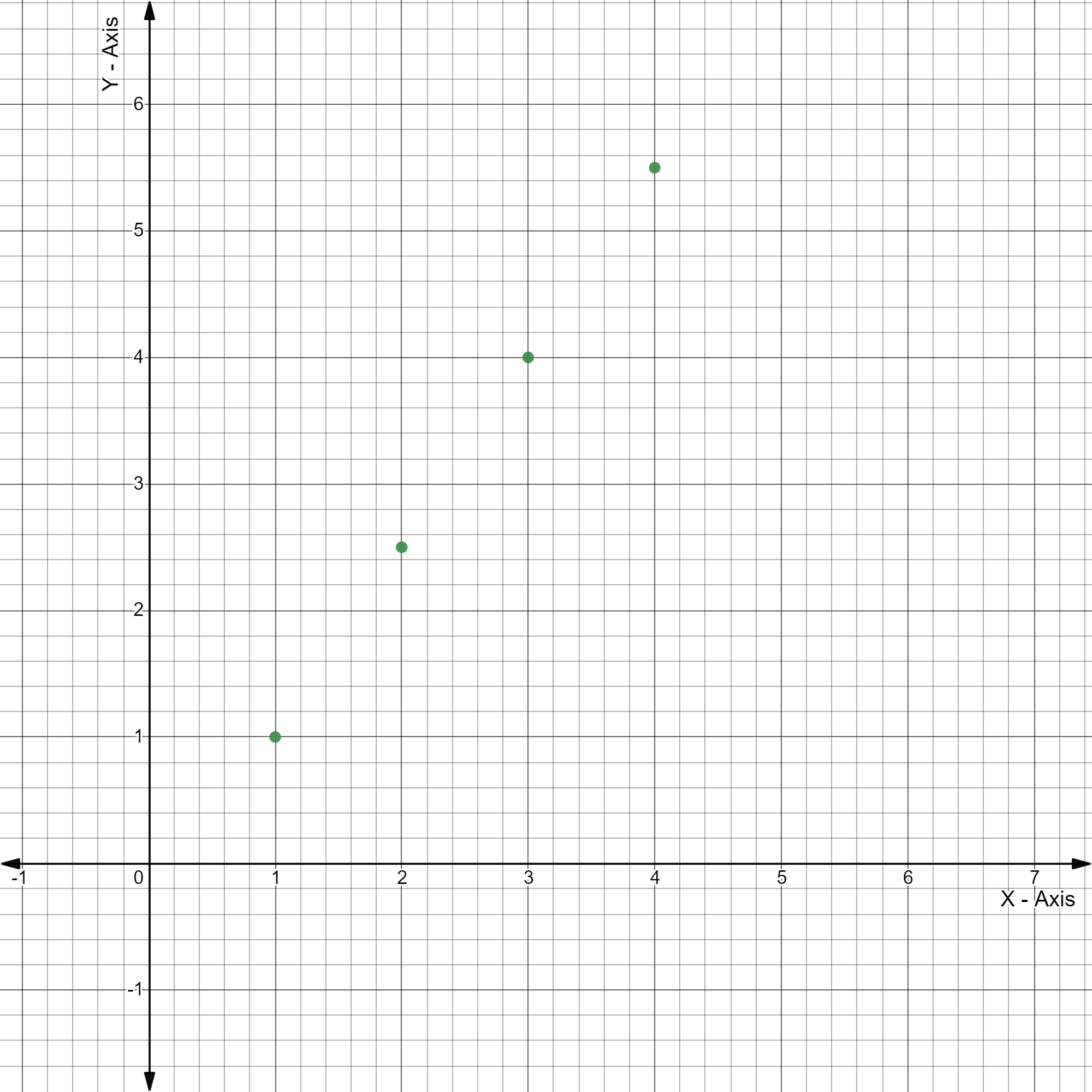
Graph of a given arithmetic sequence

Page 124 Exercise 12 Answer
Given sequence is: \(\frac{1}{4}, \frac{5}{4}, \frac{9}{4}, \frac{13}{4}\),…….
To find Graph the given arithmetic sequence.
In order to find the solution, use the order of terms,n in x- axis and the value of terms in y-axis.
To make graph , plot the points :\(\left(1, \frac{1}{4}\right)_1,\left(2, \frac{5}{4}\right)_{,}\left(3, \frac{9}{4}\right)_1\left(4, \frac{13}{4}\right)\).
Here, the Order of terms is in x-axis and the value of terms in y-axis. The Graph will be
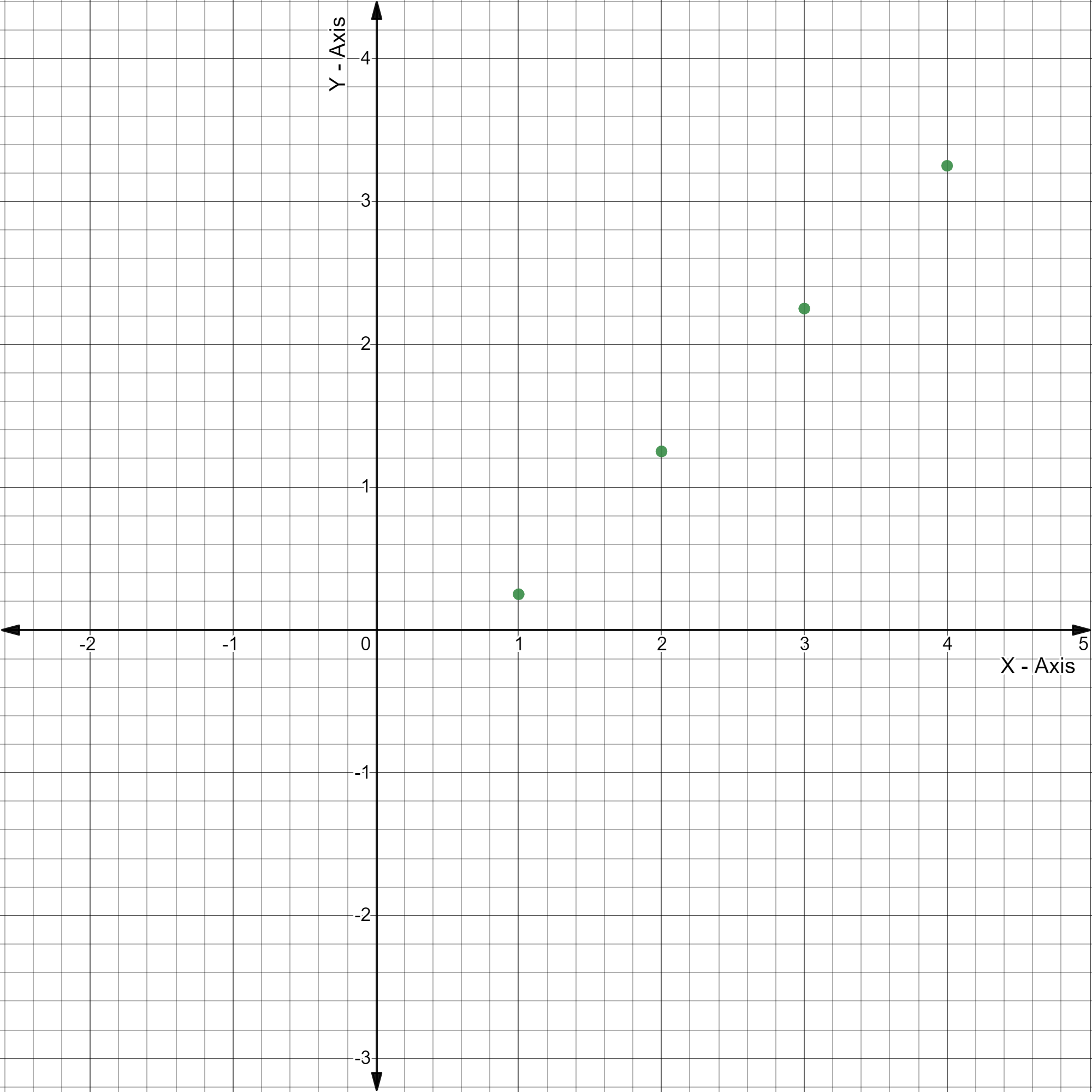
Graph of given arithmetic sequence
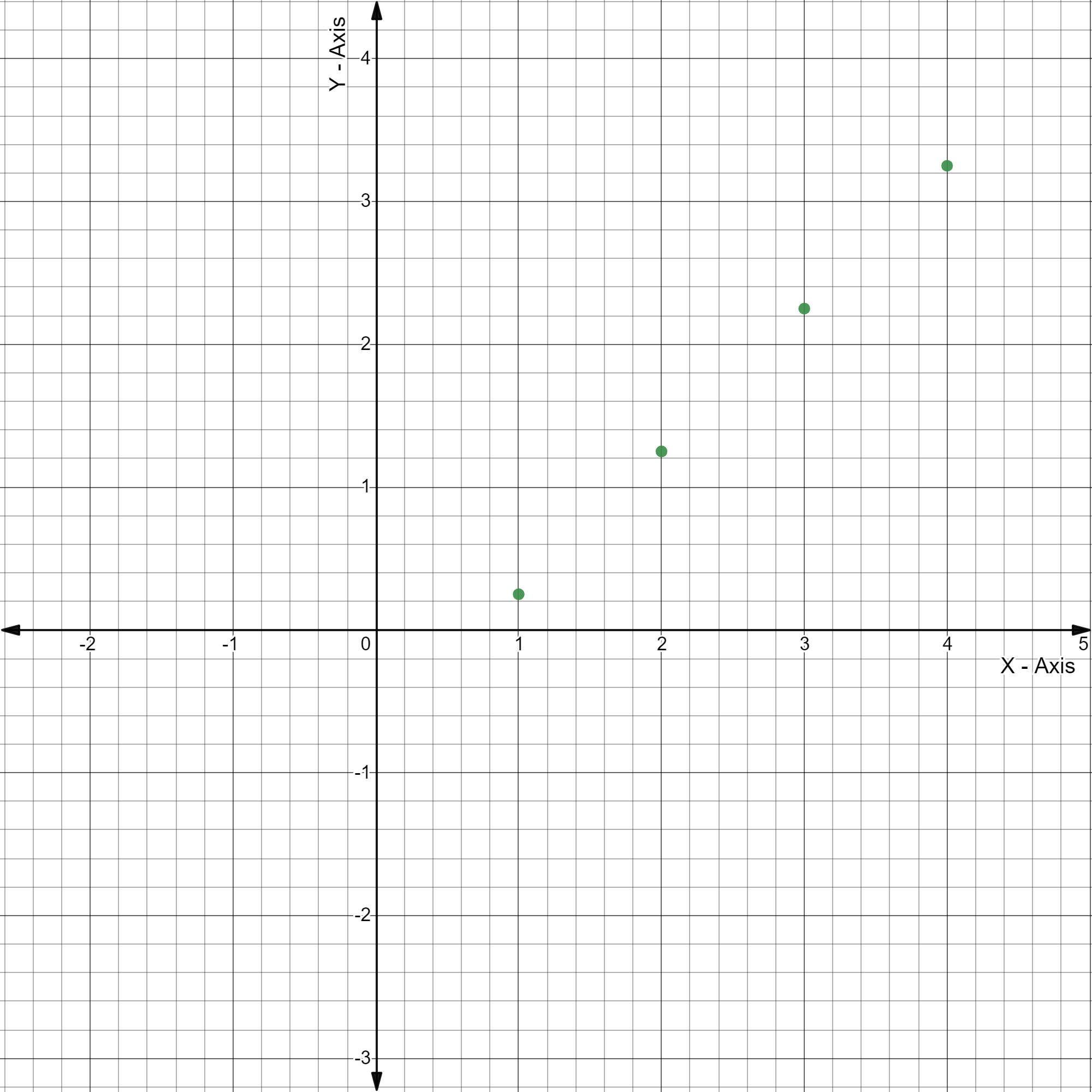
Page 125 Exercise 13 Answer
Given: Graph is
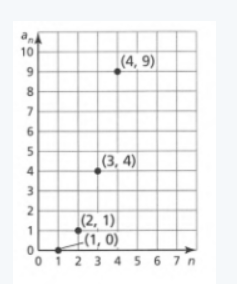
To find whether the representation is an arithmetic progression or not.
First, read the graph and write the sequence then check whether the difference between any two consecutive terms is the same or not.
By observing the graph, the ordered pairs are such that the first coordinate is the position of the term and the second coordinate is the value of the term.
So, the sequence will be a1 =0,a2=1,a3=4,a4=9
Checking whether the sequence is arithmetic progression or not.
Calculating the difference of all consecutive terms.
a2−a1
=1−0
=1
a3−a2
=4−1
=3
As the differences are not the same. So, the sequence is not an arithmetic progression.
The graph does not represent an arithmetic progression given by 0,1,4,9,…
Big Ideas Math Chapter 4 Exercise 4.6 Answer Key
Page 125 Exercise 14 Answer
Given: Graph is

To find whether the representation is an arithmetic progression or not.
First, read the graph and write the sequence then check whether the difference between any two consecutive terms is the same or not.
By observing the graph, the ordered pairs are such that the first coordinate is the position of the term and the second coordinate is the value of the term.
So, the sequence will be a1=20, a2=30, a3=40, a4=50
Checking whether the sequence is arithmetic progression or not.
Calculating the difference of all consecutive terms.
a2−a1
=30−20
=10
a3−a2
=40−30
=10
a4−a3
=50−40
=10
As the differences are the same. So, the sequence is an arithmetic progression.
The graph represents an arithmetic progression given by 20,30,40,50,…
Page 125 Exercise 15 Answer
Given: Graph is

To find whether the representation is an arithmetic progression or not.
First, read the graph and write the sequence then check whether the difference between any two consecutive terms is the same or not.
By observing the graph, the ordered pairs are such that the first coordinate is the position of the term and the second coordinate is the value of the term.
So, the sequence will be a1=21, a2=18, a3= 15,a4=12
Checking whether the sequence is arithmetic progression or not.
Calculating the difference of all consecutive terms.
a2−a1
=18−21
=−3
a3−a2
=15−18
=−3
a4−a3
=12−15
=−3
Hence, the sequence 21,18.15,12,…is an arithmetic progression.
The graph represents an arithmetic progression given by 21,18.15,12,…
Big Ideas Math Chapter 4 Writing Linear Functions Examples Exercise 4.6
Page 125 Exercise 16 Answer
Given sequence:−5.4,−6.6,−7.8,−9.0,…
To find the nth term and a10
Substitute the values of the first term and common difference in the formula for nth term and then substitute n=10i n the nth term.
The given sequence is−5.4,−6.6,−7.8,−9.0,…
First-term a=−5.4
Common difference
d=−6.6−(−5.4)
=−6.6+5.4
=−1.2
The nth term is a
=a+(n−1)d
=−5.4+(n−1)(−1.2)
=−5.4−1.2n+1.2
=−1.2n−4.2
Substitute n=10 in the nth term, we get
a10=−1.2(10)−4.2
=−12−4.2
=−16.2
The equation for nth term of the sequence is−1.2n−4.2 and a10
=−16.2
Page 125 Exercise 17 Answer
Given sequence: 43,38,33,28,…
To find the nth term and a10
Substitute the values of the first term and common difference in the formula for nth term and then substitute n=10 in the nth term.
The given sequence is 43,38,33,28,…
First-term a=43
Common difference
d=38−43
=−5
The nth term is
an=a+(n−1)d
=43+(n−1)(−5)
=43−5n+5
=−5n+48
Substitute n=10 in the nth term, we get
a10=−5(10)+48
=−50+48
=−2
The equation for nth term of the sequence is−5n+48 and a10
=−2
Page 125 Exercise 18 Answer
Given sequence: 6,10,14,18,…
To find the nth term and a10
Substitute the values of the first term and common difference in the formula for nth term and then substitute n=10 in the n th term.
The given sequence is 6,10,14,18,…
First-term a=6
Common difference
d=10−6
=4
The nth term is
an=a+(n−1)d
=6+(n−1)4
=6+4n−4
=4n+2
Substitute n=10 in the nth term, we get
a10=4(10)+2
=42
The equation for the nth term of the sequence is 4n+2 and a10=42
Page 125 Exercise 19 Answer
Given sequence :−11,−9,−7,−5,…
To find the nth term and a10
Substitute the values of the first term and common difference in the formula for nth term and then substitute n=10 in the nth term.
The given sequence is−11,−9,−7,−5,…
First-term a=−11
Common difference
d=−9−(−11)
=−9+11
=2
The nth term is
an=a+(n−1)d
=−11+(n−1)2
=−11+2n−2
=2n−13
Substitute n=10 in the nth term, we get
a10=2(10)−13
=20−13
=7
The equation for nth term of the sequence is 2n−13 and a10=7
Page 125 Exercise 20 Answer
Given sequence: 34,37,40,43,…
To find the nth term and a10
Substitute the values of first term and common difference in the formula for nth term and then substitute n=10 in the nth term.
The given sequence is 34,37,40,43,…
First-term a=34
Common difference
d=37−34
=3
The nth term is
an=a+(n−1)d
=34+(n−1)3
=34+3n−3
=3n+31
Substitute n=10 in the nth term, we get
a10=3(10)+31
=61
The equation for nth term of the sequence is 3n+31 and a10
=61
Solving Linear Functions In Exercise 4.6 Big Ideas Math
Page 125 Exercise 21 Answer
Given sequence is: \( \frac{9}{4}, \frac{7}{4}, \frac{5}{4}, \frac{3}{4}\)
To find the nth term and a10
Substitute the values of first term and common difference in the formula for nth term and then substitute n=10 in the nth term.
The given sequence is\( \frac{9}{4}, \frac{7}{4}, \frac{5}{4}, \frac{3}{4}\)
First-term a\(=\frac{9}{4}\)
Common difference
d\(=\frac{7}{4}-\frac{9}{4}\)
The nth term is an=a+(n−1)d
\(=\frac{9}{4}\)+(n−1)\(\left(\frac{-2}{4}\right)\)
\(\frac{9}{4}-\frac{2 n}{4}+\frac{2}{4}\) \(\frac{-n}{2}+\frac{11}{4}\)Substitute n=10 in the nth term, we get
a10 \(=\frac{-10}{2}+\frac{11}{4}\)
\(=\frac{-20+11}{4}\) \(=\frac{-9}{4}\)The equation for nth term of the sequence is \(\frac{-n}{2}+\frac{11}{4}\) and a10=\(=\frac{-9}{4}\)
